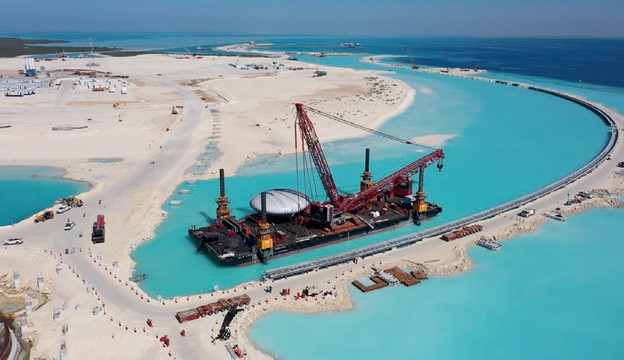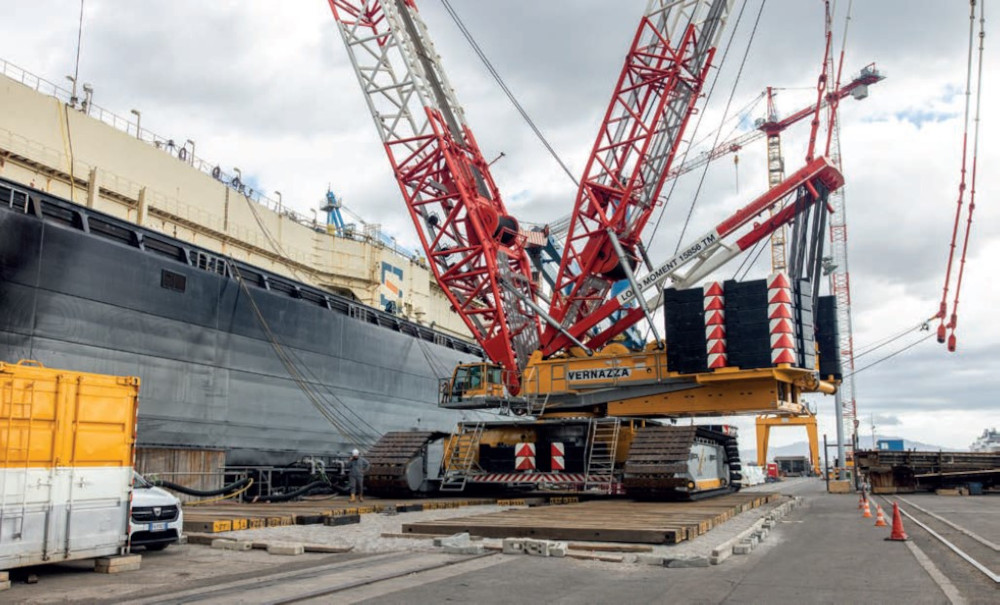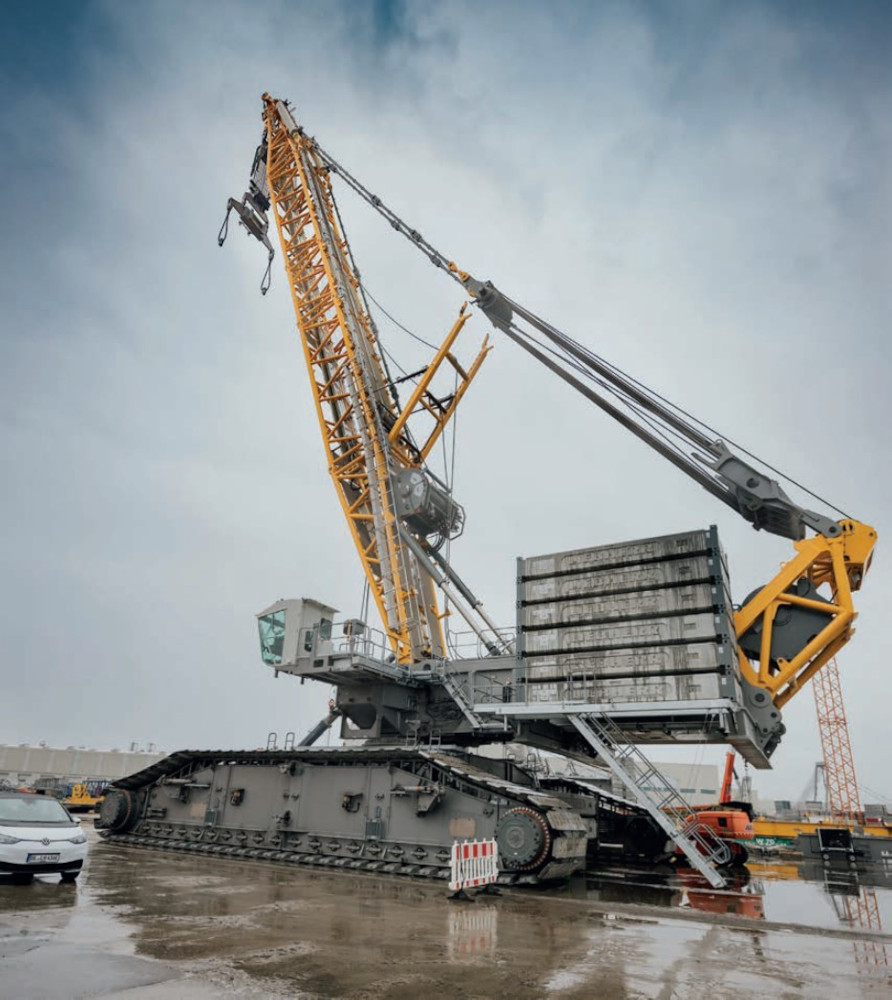Heavy Work
26 October 2023The wind energy sector often dominates demand for – and discussion of – the largest crawler cranes. There are, however, plentiful examples of their suitability for other projects. Will North reports
The heavy crawler crane market, of 650t and above, is dominated in Europe and North America by three players: Manitowoc, with its MLC 650, and Tadano and Liebherr, which both offer cranes of significantly higher capacities.
One of the drivers of demand in the sector has been the wind turbine industry. This now makes use of large crawlers globally, and in many worldwide markets these three Western companies will find themselves in competition with Chinese rivals.
Manitowoc’s MLC 650 VPC-Max was designed to increase the capacity of this 650t crane, bringing it closer to 700t rivals.
It was first deployed outside the US last year, in South Korea, by local rental company Shinui Petra, along with Manitowoc’s 3.5m wide boom strengthening system, to install 11 4.8mW Siemens wind turbines, with nacelles weighing up to 85t at heights of 130m.
The crane’s counterweight system is supported off of the ground, reducing its footprint.
This was a real benefit to Shenui Petra, says president and CEO, Choi Byung Eun: “Limits from local government authorities meant the space on the jobsite to position the crane was strictly limited to 30 m x 50 m, to preserve surrounding trees and limit damage to the ground surface.
“The only real competitor to the MLC650 needs a working radius of 44m, which immediately ruled it out.
“For these kinds of challenges, there is no other solution. Some of our customers will not consider anything other than the MLC650 because of its compact size and reduced impact on access roads and soil conditions.”
The wind energy sector will continue to push manufacturers to design bigger cranes, with higher reach, able to travel while rigged and to set up on concrete pads with limited space. But these manufacturers must continue to meet demands for cranes able to take on wide range of complex project lifts.
TAKING TO THE RED SEA
Large crawlers can play a key role in iconic architectural projects, allowing eye-catching designs to be pre-fabricated and lifted into place. Mammoet opened 2023 by getting to work on a project in the Red Sea, where it started work on a project to install 73 pre-fabricated pod villas at the Sheybarah Island Resort in Saudi Arabia.
The pods were fabricated in Sharjah, in the UAE, and transported to the resort by P&O Maritime Logistics. At the site, they were met by a Demag CC3800 (now renamed as the Tadano CC 38.650-1) mounted on Mammoet’s modified barge, the ALE 250.
The barge then sailed to the installation location, where its GPS system and jack up legs were used to position it in precise relation to the orb’s foundations.
Rather than its standard superlift system, the crane was tied back to the barge. This gave the crane enough capacity to place the orb onto the foundation without requiring the additional mass of a superlift tray.
The sleek prefabricated villas, with their steel surfaces designed to help them reflect and blend into the environment, will form part of a 3,000-bed resort due to open in 2030.
HIGH SPEED RAIL CONNECTION
The ability of cranes like this to lift large loads in one go makes them ideal for jobs where time is key. In Hazebrouck, France, Sarens had just one night to lift into place a 250t prefabricated pedestrian bridge, connecting the local train station to a multi-storey car park. The job saw a 75m long load lifted over eight train tracks, before being aligned and positioned on foundations. With the power to overhead rail lines turned off, work had to be completed before trains were due to start running.
It was important to Sarens project manager Koen Rooms that no aspect of this lift was left to chance: “The day before the operation was scheduled, we performed a test lift. It was absolutely smooth and confirmed all our calculations. This gave us the green light for the actual lift the following day, which we had to complete within a narrow time window.
“We decided to use our Tadano CC 38.650-1 for this lifting operation, and equipped it with a 54m boom in Superlift configuration. This achieves enormous lifting capacities. Moreover, thanks to its compact build, the crane is easy to set up and it can manoeuvre in even the narrowest spaces.”
The Sarens team had transported the crane to the site in the week before the weekend operation. After four days, the crane was rigged and fully inspected in the SSL configuration and its travel area was prepared with wooden mats.
The Sarens team positioned the bridge on its foundations in only five hours. “This operation involved the crane lifting the bridge to a height of up to six metres while working at a radius of 27m.
“The crane crawled over a total distance of 16m. A truly demanding task – which our Tadano crane mastered exceptionally well,” Rooms concludes.
INCREASING CAPACITY
Large crawler cranes develop in parallel with the prefabrication sector. As larger cranes become available, architects and civil engineers can design bigger prefab modules; as they do so, they come to demand larger cranes.
Sarens recently purchased the first unit of Liebherr’s new very high capacity crawler, the 2500t LR 12500-1.0, naming it Straffen (or Strong) Hendrik, in recognition of industry veteran Hendrik Sanders. The crane went from the handover in Rostock, to work nearby, where it was due to work with an 800t LR 1800-1.0 to lift fifty 1,400t wind turbine monopile foundations over a period of eight weeks. These were destined for the Baltic Eagle offshore wind farm, currently under construction 30km north of the island of Rügen.
Carl Sarens, director technical solutions, projects and engineering, said during the handover, "The capacity of the LR 12500-1.0 is enormous. Operations in the renewable energy sector, such as here in Rostock, are a particular focus for the crawler crane. The handling of offshore wind turbines in ports is becoming more and more important and the individual weights of the components are constantly increasing.”
For this first job, the overall weight of the load and required lifting attachments came to as much as 1,750t.
PIPE LAYING UPGRADE
Offshore, everything is getting bigger. Offshore wind farms will require thousands, if not tens of thousands, of large monopiles to be unloaded, as developers explore deeper waters in their rush to meet soaring demand for renewable energy. But other offshore contractors are also seeking to handle heavier loads, with larger equipment.
One such is Saipem, who has been upgrading its flagship pipe laying vessel, the Saipem Castorone. Autogru Vernazza was commissioned to lift heavy components onto the vessel, at the Forme 10 dry dock in Marseilles, France, using a Tadao CC 68.1250-1. This included lifting a DMA winch weighing 190t to a height of 30m, at a radius of 30m, onto the ship as well as a total of six 200t tensioners to a height of 40, at a radius of 50m. The heaviest load was a 500t pipeline winch with a fivekilometre steel wire rope that had to be lifted to a height of 5m at a radius of 25m.
“Only an extraordinarily powerful lattice boom crawler crane was going to be able to take care of the huge loads and large work radii. On top of that, we needed to account for the tight space conditions at the dock even with an installed Superlift system, so our CC 68.1250-1 was the way to go,” said Vernazza general manager Paolo Delfino.
ROOF REACH
The ability of these cranes to lift significant loads to large radii makes them ideal for handling long architectural components. In Spain, Gruas Aguilar has been using a Liebherr LR 17å00-1.0 and an LR 1600/2 to place steel girders for a new retractable roof at the Santiago Bernabéu Stadium, home to Real Madrid, as the world famous grounds undergo their largest ever renovation.
During the break in play caused by the World Cup in Qatar, the Madrid-based crane and transport company used two Liebherr crawler cranes to assemble the girders for the retractable roof. An LR 1700- 1.0 and an LR 1600/2 lifted twelve 72m-long and 72t cross beams to a height of 70 metres in tandem lifts. The two crawler cranes were positioned outside the stadium and had to cope with radii of 70 to 118 metres.
Originally, the assembly of the roof cross beams was to be carried out using a single, larger crane. After extensive testing, this plan had to be discarded due to, among other things, space problems in the vicinity of the construction site and the large assembly radii. Instead, Grúas Aguilar opted for tandem lifts using the LR 1700-1.0 and LR 1600/2 crawler cranes.
The Grúas Aguilar team and its cranes also had to overcome several major challenges when carrying out this exceptional operation. In particular, the limited space around the stadium made it extremely difficult to erect large lattice boom cranes. This meant that the boom of the LR 1600/2 had to be mounted in a car park near the stadium.
Another difficulty was that the crane operators could not always see the cross beams when lifting them into the stadium. To ensure the success of the assembly, Grúas Aguilar's design department meticulously planned the movements of each girder in advance, taking into account the respective angles of the main boom and luffing jib of the two cranes in each phase.
First of kind wind turbines in Australia installed using crawler combo
French renewable energy producer Neoen commissioned heavy lift and transport company Mammoet to install 28 wind turbines with a hub height of 149 metres at a remote site in Queensland, Australia.
The wind turbines, the first of their type in Australia, were installed at the Kaban Green Power Hub using a Terex Demag AC700 and a Liebherr LG 1750SX.
The Terex Demag AC700 crane was used for the combined offloading and preassembly scope. The 700t capacity hydraulic crane was engineered to set up in a single optimal position, which enabled a two-stage offloading process with intermediate preassembly. This approach decreased the number of teams required on-site from three to two, and minimised crane movements needed between lifts.
The Liebherr LG 1750SX, equipped with a 151m main boom and 12m fixed fly, lifted the powertrains of the EnVentus TM V162-5.6 MW turbines, each weighing 92t, to a hub height of 149m. Once fully assembled the turbines stood at an impressive tip height of 226m.
Mammoet used a fleet of Scheuerle SPMT and Goldhofer THP multi-axle trailers to manoeuvre 400t of superlift counterweight at once, supporting the LG1750 installation, and up to 280t of counterweight at once during on-site relocations. This method not only accelerated operations but also reduced the number of truck and trailer trips, Mammoet claimed.
 A Tadano CC 38.650-1 installing pre-fabricated pod villas, at the Sheybarah Island Resort in Saudi Arabia, mounted on Mammoet’s modified barge, the ALE 250
A Tadano CC 38.650-1 installing pre-fabricated pod villas, at the Sheybarah Island Resort in Saudi Arabia, mounted on Mammoet’s modified barge, the ALE 250
 Gruas Aguilar used a Liebherr LR 1700-1.0 and an LR 1600/2 to place steel girders for a roof at the Santiago Bernabéu Stadium, Spain, home to Real Madrid
Gruas Aguilar used a Liebherr LR 1700-1.0 and an LR 1600/2 to place steel girders for a roof at the Santiago Bernabéu Stadium, Spain, home to Real Madrid
 Autogru Vernazza used a Tadao CC 68.1250-1 to load the Saipem Castorone in Marseilles, France. The work included lifting a DMA winch weighing 190t to a height of 30m
Autogru Vernazza used a Tadao CC 68.1250-1 to load the Saipem Castorone in Marseilles, France. The work included lifting a DMA winch weighing 190t to a height of 30m
 Sarens named the crane Straffen (or Strong) Hendrik in recognition of industry veteran Hendrik Sanders (pictured)
Sarens named the crane Straffen (or Strong) Hendrik in recognition of industry veteran Hendrik Sanders (pictured)




